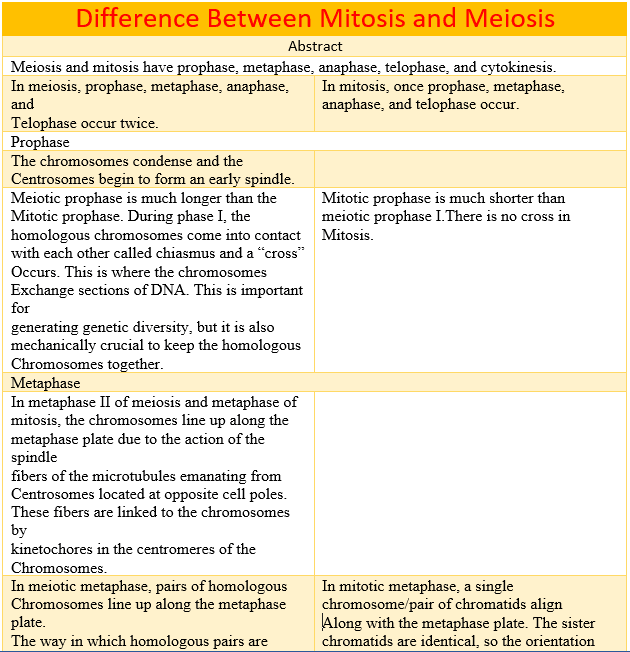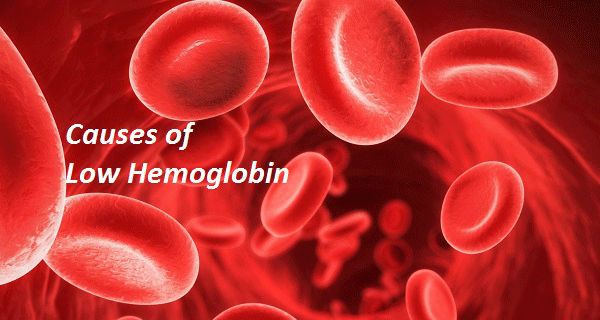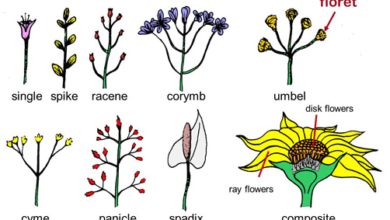Difference between Mitosis and Meiosis
The Difference between Mitosis and Meiosis is Organisms grow and reproduce by dividing cells. In eukaryotic cells, the production of  new cells is the result of meiosis and mitosis. These two processes of mitosis are similar but distinct. Both processes involve separating a dye cell or a cell containing two sets of chromosomes (one chromosome donated by each parent).
new cells is the result of meiosis and mitosis. These two processes of mitosis are similar but distinct. Both processes involve separating a dye cell or a cell containing two sets of chromosomes (one chromosome donated by each parent).
In single-celled organisms, cell proliferation produces the next generation. In multicellular organisms, cell division takes place not only to produce a completely new organism but also to grow and replace obsolete cells in the organism. Cell division is always highly organized and follows a series of very coordinated steps.
Cellular degradation refers to the division of cells into halves, while meiosis and meiosis refer to two different forms of nuclear division. Threaded division causes the nucleus to be the same as the original nucleus. On the other hand, meiosis produces four cores, each with chromosomes from the original cell. In animals, meiosis occurs only in cells that produce sexual cells (gamete), that is, eggs and sperm.
let’s have a look at the Differences between Mitosis and Meiosis.
Key Points (Mitosis VS Meiosis)
- Mitosis divides the division of body cells, while meiosis divides mitotic cells.
- Cell division occurs once during mitosis and twice during meiosis.
- Two daughter cells are produced after cell division and division, and four daughter cells are produced after meiosis.
- The daughter cells produced by mitosis are diploid, while the cells produced by meiosis are single chromosomes.
- Daughter cells are the product of genetically identical divisions. The daughter cells produced after meiosis are genetically diverse.
- The quadruple occurs in meiosis but does not divide.
Let’s have a look at Mitosis and Meiosis individually.
What is Mitosis?
Mitosis and meiosis are processes of cell division. Organisms are constantly replenishing their cell supply and creating new cells to replace old or damaged ones and causing cells to be used to create new organisms during sexual reproduction. Mitosis occurs in somatic cells (all cells that are not sex cells), and it is a critical process for producing new cells and keeping the body alive and healthy.
Most cells in the human body only last a few days or weeks (with the exception of brain cells, which usually last a lifetime), so your body must constantly produce new cells by mitosis. All cells go through a process of formation, growth, division, and eventual death. During mitosis, the stem cell nucleus divides to form two sets of chromosomes for each of the new daughter cells.
What is Meiosis?
The process which cell division occurs through the sexual reproduction of organisms, after two nuclear divisions (meiosis I and meiosis II), and results in the production of four haploid gametes or sex cells. Each cell contains a pair of homologous chromosomes, which means paternal and maternal chromosomes are distributed randomly between the cells.
The nuclear division also includes four phases: prophase, metaphase, anaphase, and telophase. At the interface, the cells duplicate, the chromosomes condense and shoot at the opposite ends and pair with their counterparts at the time of crossing. In addition, the cell divides and forms two cells. These are the processes of meiosis I, and then these two newly formed cells undergo the process of meiosis II.
Comparison between Mitosis and Meiosis
This article will explore the characteristics of the two types of cell division, highlighting their similarity and crucial aspects. We will also explore research on these processes and how cell division could go wrong to cause disease states such as cancer and Down syndrome.
Difference between Mitosis and Meiosis
- The process of cell division that occurs for the replacement of somatic cells (excluding sex cells) and that is useful in the body’s repair and growth mechanism is known as mitosis. It is known to occur in the case of vegetative reproduction or asexual reproduction. On the other hand, the process of cell division known for the production of sex cells such as ovules or sperm, and supports sexual reproduction through gametogenesis is called meiosis.
2. The necessary steps to complete the cycle of mitosis are prophase, metaphase, anaphase, and telophase, but in meiosis, where the division is divided into two main stages such as meiosis I: prophase I, metaphase I, Anaphase I, Telophase I; and Meiosis II: prophase II, metaphase II, anaphase II and telophase II.
3. Mitosis occurs in somatic cells and, therefore, there is no synapse or crossover process, while meiosis occurs in germ cells and synapse and crossover occur in homologous chromosomes during meiosis I.
4. As the main objective of mitosis is the growth of the body, even after cell division, the genetic identity remains the same even after division.
5. But in meiosis genetic variation is observed during division, because these cells are useful for the production of sex cells.
6. Mitosis has only one nuclear division, and no homologous chromosome participates in the pairing, on the contrary, meiosis has two nuclear divisions, and the pairing is produced from homologous chromosomes.
7. The stem cell can be haploid or diploid, which gives birth to only two daughter cells (diploid) in the case of mitosis, but the stem cell is always diploid and gives birth to four daughter cells (haploid) in meiosis.
8. The number of chromosomes remains the same in mitosis, but the number of chromosomes is halved in meiosis.
9. The nucleoli reappear in telophase, but chiasmus is absent, even karyokinesis occurs during the interphase, but cytokinesis occurs during telophase in mitosis, while in meiosis, nucleoli are absent in telophase I, chiasmus is observed during prophase I and metaphase I, even karyokinesis takes place at Interface I; Cytokinesis occurs in telophase I and II.
10. In mitosis, the division of the centromeres takes place during the anaphase, the spindle fibers disappear completely in the telophase, while there is no such division of the centromere in the anaphase I and II, and the spindle fibers are present in the Telophase I.
11. The duration of Prophase is short (only a few hours) and is simple in mitosis. On the other hand, the process is prophetic is complicated and takes more time (it can take days).
12. Mitosis is functional at the time of cell growth and active during the repair and healing mechanisms of the body.
Meiosis plays an important role in gamete formation and sexual reproduction and is active in maintaining the number of chromosomes.
Difference Between Mitosis and Meiosis Comparison Table | |
Abstract | |
| Meiosis and mitosis have prophase, metaphase, anaphase, telophase, and cytokinesis. | |
| In meiosis, prophase, metaphase, anaphase, and Telophase occur twice. | In mitosis, once prophase, metaphase, anaphase, and telophase occur. |
Prophase | |
| The chromosomes condense and the Centrosomes begin to form an early spindle. | |
| The meiotic prophase is much longer than the Mitotic prophase. During phase I, the homologous chromosomes come into contact with each other called chiasmus and a “cross” Occurs. This is where the chromosomes Exchange sections of DNA. This is important for generating genetic diversity, but it is also mechanically crucial to keep the homologous Chromosomes together. | Mitotic prophase is much shorter than meiotic prophase I. There is no cross in Mitosis. |
Metaphase | |
| In metaphase II of meiosis and metaphase of mitosis, the chromosomes line up along the metaphase plate due to the action of the spindle fibers of the microtubules emanating from Centrosomes located at opposite cell poles. These fibers are linked to the chromosomes by kinetochores in the centromeres of the Chromosomes. | – |
| In meiotic metaphase, pairs of homologous chromosomes line up along the metaphase plate. The way in which homologous pairs are randomly oriented with respect to cell poles is known as the independent matching law and guarantees a random and independent distribution of chromosomes to daughter cells of meiosis I and, ultimately, to the gametes. Haploids at the end of meiosis II. | In mitotic metaphase, a single chromosome/pair of chromatids align Along with the metaphase plate. The sister chromatids are identical, so the orientation of the chromosome has no meaning. |
Anaphase | |
| In anaphase, the chromosomes are divided into opposite poles of the cell. | – |
| In meiosis anaphase, the cohesion in the chromosome centromeres is not cleaved and, therefore, continues to hold the sister chromatids together while the homologous chromosomes separate at the poles of opposite cells. | In the anaphase of mitosis (and meiosis II), the cohesion protein that holds the centromeres of the sister chromatids together is cleaved, allowing the sister chromatids to separate at opposite poles of the cell, at which |
Telophase | |
| The nuclear membrane reforms around the newly separated chromosomes, which begin to unfold, and become less condensed. The spindle microtubules dissociate. Each daughter cell will inherit a centrosome. | |
Similarities in Mitosis and Meiosis
After the Difference between Mitosis and Meiosis, here we discuss some interesting similarities or anti-difference between Mitosis and Meiosis. Check out these anti Difference facts between Mitosis and Meiosis:
- Mitosis and meiosis occur in the nucleus of the cell and are observable under the light microscope.
- The process involves the division of the cell.
- Mitosis and meiosis occur in the M phase of the cell cycle.
- Prophase, metaphase, anaphase, and telophase are the typical stages of the two cycles.
- DNA synthesis occurs in both cycles.
- There is no involvement of heart muscle cells and nerve tissue in the process of mitosis and meiosis because once formed, they no longer undergo division.
Active Research Questions
After discussing a lot about the difference between Mitosis and Meiosis, now the active research question on the Difference between Mitosis and Meiosis is mentioned here for Quick Support and Reader Assistance. Let’s rock the Topic!
How do cells promote faithful chromosomal segregation in mitosis?
While there is only one way for mitosis to go well, there are many ways it can go wrong. For example, in early mitosis, if there is incorrect contact between microtubules and chromosomes, the chromosomes can be misaligned, which can lead to incorrect segregation of the sister chromatids. In late mitosis, how is the cell certain that the time has come to perform cytokinesis?
The passenger chromosomal complex (CPC) is a molecular guardian angel that acts at many stages of mitosis to ensure the fidelity of the process. At the beginning of mitosis, the CPC is located in all chromosomes and acts to modify the chromatin, during mitosis it moves towards the chromosomal centromeres to prevent the binding of incorrect microtubules and before cytokinesis, the CPC finds its way to the Central Zone, Therefore, an ongoing research question is how the CPC relocates elegantly throughout mitosis to save the day.
How are homologous chromosomes held together and then separated in meiosis I?
You can remember from the above Difference between Mitosis and Meiosis that it is the cohesion protein that binds the sister chromatids in the metaphase of mitosis and metaphase II of meiosis. However, in meiosis I, homologous chromosomes must be held together in metaphase I, before these bonds break rapidly during anaphase I. This feat is accomplished by a miraculous cell zipper called the synaptonemal complex (SC).
This zipper must be strong enough to hold the chromosomes together, but it must also be effectively dismantled, otherwise, the homologous chromosomes will not separate accurately in anaphase I, which will lead to a potentially disastrous genetic inequality in the daughter cells How exactly is this zipper separates is a hot topic of research.
You May Also Like:





